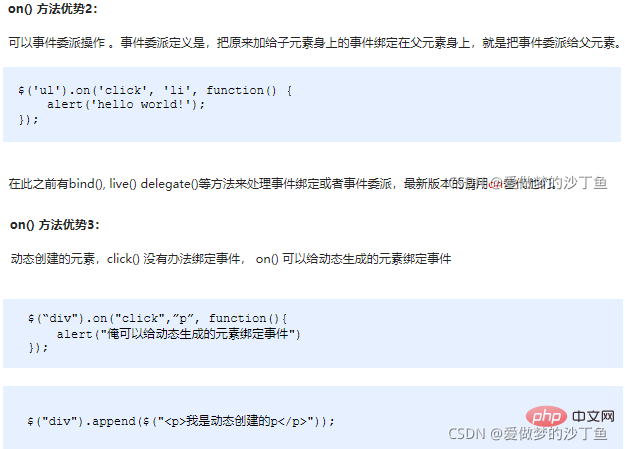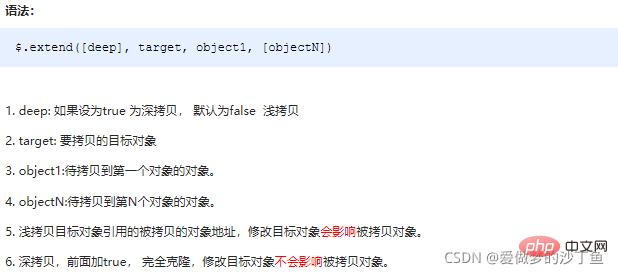How to bind and unbind events in jquery? (detailed code explanation)
In the previous article "18 JavaScript Optimization Tips You Need to Know", we introduced some tips in JavaScript. In this article, let's take a look at how to bind jquery events. I hope it will be helpful to everyone with the relevant knowledge about setting and unbinding.

jQuery event binding and unbinding
1.1. jQuery event registration
jQuery provides us with a convenient event registration mechanism, which makes developers depressed. The advantages and disadvantages of the operation are as follows:
Advantages: The operation is simple, and there is no need to worry about event coverage and other issues.
Disadvantages: Ordinary event registration cannot be used for event delegation, and event unbinding cannot be achieved, so other methods are required.
Syntax

Demo code
<body>
<div></div>
<script>
$(function() {
// 1. 单个事件注册
$("div").click(function() {
$(this).css("background", "purple");
});
$("div").mouseenter(function() {
$(this).css("background", "skyblue");
});
})
</script>
</body>1.2. jQuery event handling
Due to the shortcomings of ordinary registration event methods, jQuery has developed multiple processing methods. The key points are as follows:
on(): used for event binding, currently the most useful event. Binding method
off(): event unbinding
trigger() / triggerHandler(): event trigger
1.2.1 Event processing on() binding event
Due to the shortcomings of ordinary registration event methods, jQuery has created multiple new event binding methods bind () / live() / delegate() / on(), etc., the best of which is: on()
Syntax


Demo code
<body>
<div></div>
<ul>
<li>我们都是好孩子</li>
<li>我们都是好孩子</li>
<li>我们都是好孩子</li>
</ul>
<ol></ol>
<script>
$(function() {
// (1) on可以绑定1个或者多个事件处理程序
// $("div").on({
// mouseenter: function() {
// $(this).css("background", "skyblue");
// },
// click: function() {
// $(this).css("background", "purple");
// }
// });
$("div").on("mouseenter mouseleave", function() {
$(this).toggleClass("current");
});
// (2) on可以实现事件委托(委派)
// click 是绑定在ul 身上的,但是 触发的对象是 ul 里面的小li
// $("ul li").click();
$("ul").on("click", "li", function() {
alert(11);
});
// (3) on可以给未来动态创建的元素绑定事件
$("ol").on("click", "li", function() {
alert(11);
})
var li = $("<li>我是后来创建的</li>");
$("ol").append(li);
})
</script>
</body>1.2.3. Event processing off() unbinding event
When the logic above an event, in a specific When it is no longer needed according to requirements, the logic on the event can be removed. This process is called event unbinding. jQuery provides us with a variety of event unbinding methods: die() / undelegate() / off(), etc., and there is even an event binding method one() that only triggers once. Here we focus on off();
Syntax

Demo code
<body>
<div></div>
<ul>
<li>我们都是好孩子</li>
<li>我们都是好孩子</li>
<li>我们都是好孩子</li>
</ul>
<p>我是一个P标签</p>
<script>
$(function() {
// 事件绑定
$("div").on({
click: function() {
console.log("我点击了");
},
mouseover: function() {
console.log('我鼠标经过了');
}
});
$("ul").on("click", "li", function() {
alert(11);
});
// 1. 事件解绑 off
// $("div").off(); // 这个是解除了div身上的所有事件
$("div").off("click"); // 这个是解除了div身上的点击事件
$("ul").off("click", "li");
// 2. one() 但是它只能触发事件一次
$("p").one("click", function() {
alert(11);
})
})
</script>
</body>1.2.4. Event processing trigger() automatically triggers events
Sometimes, under certain specific conditions, we hope that certain events can be automatically triggered, such as the automatic playback function of the carousel image being consistent with clicking the button on the right. You can use a timer to automatically trigger the click event on the right button without having to click the mouse. From this jQuery provides us with two automatic trigger events trigger() and triggerHandler();
Syntax

Demo code
<body>
<div></div>
<input type="text">
<script>
$(function() {
// 绑定事件
$("div").on("click", function() {
alert(11);
});
// 自动触发事件
// 1. 元素.事件()
// $("div").click();会触发元素的默认行为
// 2. 元素.trigger("事件")
// $("div").trigger("click");会触发元素的默认行为
$("input").trigger("focus");
// 3. 元素.triggerHandler("事件") 就是不会触发元素的默认行为
$("input").on("focus", function() {
$(this).val("你好吗");
});
// 一个会获取焦点,一个不会
$("div").triggerHandler("click");
// $("input").triggerHandler("focus");
});
</script>
</body>1.3. jQuery event object
jQuery encapsulates the event object event in the DOM, with better compatibility, easier acquisition, and little change in usage. When an event is triggered, an event object is generated.
Syntax

Demo code
<body>
<div></div>
<script>
$(function() {
$(document).on("click", function() {
console.log("点击了document");
})
$("div").on("click", function(event) {
// console.log(event);
console.log("点击了div");
event.stopPropagation();
})
})
</script>
</body>Note: The event object in jQuery can be used for reference from the event in API and DOM.
1.4. jQuery copy object
jQuery provides us with two sets of APIs to quickly obtain and set the size and position of elements, which are convenient and easy to use. The contents are as follows.
Syntax

Demo code
<script>
$(function() {
// 1.合并数据
var targetObj = {};
var obj = {
id: 1,
name: "andy"
};
// $.extend(target, obj);
$.extend(targetObj, obj);
console.log(targetObj);
// 2. 会覆盖 targetObj 里面原来的数据
var targetObj = {
id: 0
};
var obj = {
id: 1,
name: "andy"
};
// $.extend(target, obj);
$.extend(targetObj, obj);
console.log(targetObj);
})
</script>1.5. jQuery multi-library coexistence
Actual During development, many projects have been developed continuously for more than ten years, and jQuery versions are constantly updated. The initial jQuery version cannot meet the needs. At this time, it is necessary to ensure that new functions are implemented using the new jQuery version while the old version runs normally. This This situation is called the coexistence of multiple jQuery libraries.
Grammar

Demo code
<script>
$(function() {
// 让jquery 释放对$ 控制权 让用自己决定
var suibian = jQuery.noConflict();
console.log(suibian("span"));
})
</script>Related video tutorial recommendations: jQuery video tutorial
The above is the detailed content of How to bind and unbind events in jquery? (detailed code explanation). For more information, please follow other related articles on the PHP Chinese website!

Hot AI Tools

Undresser.AI Undress
AI-powered app for creating realistic nude photos

AI Clothes Remover
Online AI tool for removing clothes from photos.

Undress AI Tool
Undress images for free

Clothoff.io
AI clothes remover

Video Face Swap
Swap faces in any video effortlessly with our completely free AI face swap tool!

Hot Article

Hot Tools

Notepad++7.3.1
Easy-to-use and free code editor

SublimeText3 Chinese version
Chinese version, very easy to use

Zend Studio 13.0.1
Powerful PHP integrated development environment

Dreamweaver CS6
Visual web development tools

SublimeText3 Mac version
God-level code editing software (SublimeText3)

Hot Topics
 1386
1386
 52
52
 Detailed explanation of jQuery reference methods: Quick start guide
Feb 27, 2024 pm 06:45 PM
Detailed explanation of jQuery reference methods: Quick start guide
Feb 27, 2024 pm 06:45 PM
Detailed explanation of jQuery reference method: Quick start guide jQuery is a popular JavaScript library that is widely used in website development. It simplifies JavaScript programming and provides developers with rich functions and features. This article will introduce jQuery's reference method in detail and provide specific code examples to help readers get started quickly. Introducing jQuery First, we need to introduce the jQuery library into the HTML file. It can be introduced through a CDN link or downloaded
 How to use PUT request method in jQuery?
Feb 28, 2024 pm 03:12 PM
How to use PUT request method in jQuery?
Feb 28, 2024 pm 03:12 PM
How to use PUT request method in jQuery? In jQuery, the method of sending a PUT request is similar to sending other types of requests, but you need to pay attention to some details and parameter settings. PUT requests are typically used to update resources, such as updating data in a database or updating files on the server. The following is a specific code example using the PUT request method in jQuery. First, make sure you include the jQuery library file, then you can send a PUT request via: $.ajax({u
 In-depth analysis: jQuery's advantages and disadvantages
Feb 27, 2024 pm 05:18 PM
In-depth analysis: jQuery's advantages and disadvantages
Feb 27, 2024 pm 05:18 PM
jQuery is a fast, small, feature-rich JavaScript library widely used in front-end development. Since its release in 2006, jQuery has become one of the tools of choice for many developers, but in practical applications, it also has some advantages and disadvantages. This article will deeply analyze the advantages and disadvantages of jQuery and illustrate it with specific code examples. Advantages: 1. Concise syntax jQuery's syntax design is concise and clear, which can greatly improve the readability and writing efficiency of the code. for example,
 How to remove the height attribute of an element with jQuery?
Feb 28, 2024 am 08:39 AM
How to remove the height attribute of an element with jQuery?
Feb 28, 2024 am 08:39 AM
How to remove the height attribute of an element with jQuery? In front-end development, we often encounter the need to manipulate the height attributes of elements. Sometimes, we may need to dynamically change the height of an element, and sometimes we need to remove the height attribute of an element. This article will introduce how to use jQuery to remove the height attribute of an element and provide specific code examples. Before using jQuery to operate the height attribute, we first need to understand the height attribute in CSS. The height attribute is used to set the height of an element
 jQuery Tips: Quickly modify the text of all a tags on the page
Feb 28, 2024 pm 09:06 PM
jQuery Tips: Quickly modify the text of all a tags on the page
Feb 28, 2024 pm 09:06 PM
Title: jQuery Tips: Quickly modify the text of all a tags on the page In web development, we often need to modify and operate elements on the page. When using jQuery, sometimes you need to modify the text content of all a tags in the page at once, which can save time and energy. The following will introduce how to use jQuery to quickly modify the text of all a tags on the page, and give specific code examples. First, we need to introduce the jQuery library file and ensure that the following code is introduced into the page: <
 Use jQuery to modify the text content of all a tags
Feb 28, 2024 pm 05:42 PM
Use jQuery to modify the text content of all a tags
Feb 28, 2024 pm 05:42 PM
Title: Use jQuery to modify the text content of all a tags. jQuery is a popular JavaScript library that is widely used to handle DOM operations. In web development, we often encounter the need to modify the text content of the link tag (a tag) on the page. This article will explain how to use jQuery to achieve this goal, and provide specific code examples. First, we need to introduce the jQuery library into the page. Add the following code in the HTML file:
 How to tell if a jQuery element has a specific attribute?
Feb 29, 2024 am 09:03 AM
How to tell if a jQuery element has a specific attribute?
Feb 29, 2024 am 09:03 AM
How to tell if a jQuery element has a specific attribute? When using jQuery to operate DOM elements, you often encounter situations where you need to determine whether an element has a specific attribute. In this case, we can easily implement this function with the help of the methods provided by jQuery. The following will introduce two commonly used methods to determine whether a jQuery element has specific attributes, and attach specific code examples. Method 1: Use the attr() method and typeof operator // to determine whether the element has a specific attribute
 Understand the role and application scenarios of eq in jQuery
Feb 28, 2024 pm 01:15 PM
Understand the role and application scenarios of eq in jQuery
Feb 28, 2024 pm 01:15 PM
jQuery is a popular JavaScript library that is widely used to handle DOM manipulation and event handling in web pages. In jQuery, the eq() method is used to select elements at a specified index position. The specific usage and application scenarios are as follows. In jQuery, the eq() method selects the element at a specified index position. Index positions start counting from 0, i.e. the index of the first element is 0, the index of the second element is 1, and so on. The syntax of the eq() method is as follows: $("s




